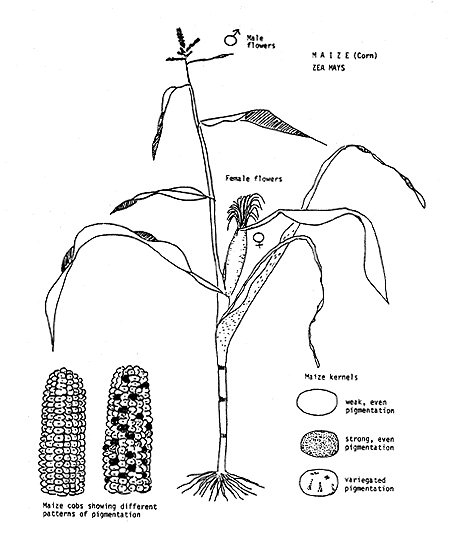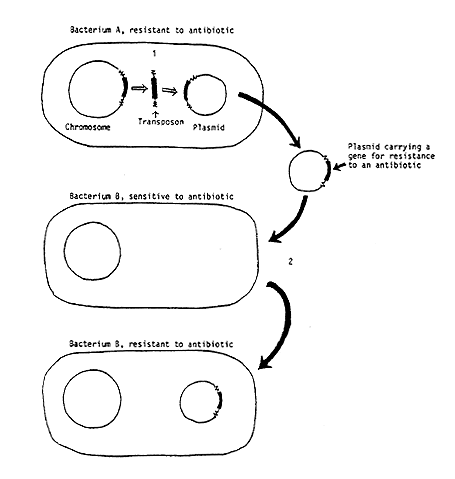Press release

NOBELFÖRSAMLINGEN KAROLINSKA INSTITUTET
THE NOBEL ASSEMBLY AT THE KAROLINSKA INSTITUTE
The Nobel Assembly of the Karolinska Institute has today decided to award the Nobel Prize in Physiology or Medicine for 1983 to
Barbara McClintock
for her discovery of “mobile genetic elements”.
Summary
Barbara McClintock discovered mobile genetic elements in plants more than 30 years ago. The discovery was made at a time when the genetic code and the structure of the DNA double helix were not yet known. It is only during the last ten years that the biological and medical significance of mobile genetic elements has become apparent. This type of element has now been found in microorganisms, insects, animals and man, and has been demonstrated to have important functions.
Genetic instability was originally discovered in maize (Zea mays) in which it was found to cause altered patterns of pigmentation of the kernels. Instead of being evenly pigmented, the kernels have sectors of more intense pigmentation. The spots vary in size and colour. At the same time, the cells show chromosome breaks and other abnormalities. McClintock examined the relationship between the pigmentation pattern the kernels and chromosome changes. Variegation in the colour of the kernels was found to be parallelled by transposition of structural elements within or between chromosomes. Because transpositions result in inactivation of neighbouring genes, McClintock used the term “controlling elements” to describe the mobile chromosome structures. Another effect of transposition was chromosome breaks at points where the mobile elements were integrated.
During the mid-1960s mobile genetic elements were demonstrated in bacteria and shown to play a role in the transmission of resistance to antibiotics from one bacterium to another.
Such elements were also found to have an important function in the ability of unicellular parasites (trypanosomes) to change their surface properties, thereby avoiding the immune response of the host organism. Recombination of DNA segments proved to be an essential factor in the ability of lymphoid cells to produce a seemingly infinite number of different antibodies to foreign substances. In recent years, evidence has accumulated that transposition of genes or incomplete genes are involved in the transformation of normal cells into tumour cells. Thus, genes controlling cell growth have been found to undergo translocation from chromosome to another during cancerogenesis. The initial discovery of mobile genetic elements by Barbara McClintock is of great medical and biological significance. It has also resulted in new perspectives on how genes are formed and how they change during evolution.
When McClintock began the work that led to the discovery of mobile genetic elements, genetic instability had been demonstrated in plants and insects (Drosophila). In maize, the instability caused the kernels to show differently coloured patches. This variegation was believed to reflect a greater fragility of certain chromosome regions, causing genes for pigmentation to mutate more easily than other genes. As daughter cells multiplied and inherited the mutant genes, colonies of cells with an altered pattern of pigmentation were formed.
McClintock first examined the structure of chromosomes in maize plants showing variegation in pigmentation. By combining results from these studies with those from genetic crosses she was able to localize genes for e.g. type of starch, storage protein, anthocyanin pigments on the individual chromosomes. Of the ten pairs of chromosomes pair number 9 turned out to be of particular interest.
The choice of maize presented several experimental advantages. Each ear (Fig. 1) has several hundred kernels, each of which is the result of an independent fertilization event. The inheritance of a series of characteristics can easily be studied simply by examining the structure, starch content or pigmentation of the individual kernels. Mutations affecting pigmentation are particularly useful, not only because they can be easily observed, but also because they do not harm the multiplication of the cells. Therefore, if a single cell undergoes a mutation or other form of heritable change during the development of the kernels, this will result in altered pigmentation of several successive generations of daughter cells. The number and size of the differently coloured spots, therefore, provides important information on the extent of genetic instability and the point during development at which the genetic change took place.
 |
| Figure 1. Schematic summary of the maize plant, its maize cobs and maize kernels. |
Another advantage of maize as an experimental system was that individual chromosomes are easily studied. During the 1930s McClintock made an important contribution to plant genetics by describing the detailed morphology of normal and altered maize chromosomes. This work was a necessary condition for the discovery of mobile genetic elements.
The first mobile element characterized by McClintock was found on chromosome number 9, where it caused chromosome breaks (Fig. 2). Since the chromosome was divided into two parts, this element was named “dissociation” or Ds. As it was transposed along chromosome 9 it caused breaks and inactivitation of neighbouring genes. McClintock, therefore, referred to the mobile elements as “control elements”. In order for Ds to be transposed, a second genetic element called “activator” (Ac) had to be present. Together Ds and Ac represented a two element system controlling gene activity. McClintock also identified different forms of Ds, some causing complete gene inactivation while others resulted in different degrees of partial gene inactivation. The role of the Ac element was shown to be a coordinating one. By signalling to Ds elements, Ac triggered the transposition of one or several such elements. Also the Ac element occurred in different forms. Some of these produced signals early during the development of the kernel, while others induced transpositions late in development. The type of Ac element could be detected by examining the size of differently pigmented spots on the surface of the kernels.

Figure 2. When the control element Ds jumps from its “resting” position between genes number 8 and 9 to a position close to gene number 4, the latter is switched off. If Ds later moves to another position, gene 4 will resume its function and the corresponding protein will again be synthesized.
In later work, McClintock demonstrated regions of genetic instability on other maize chromosomes. Also in these cases the phenomena observed turned out to be due to genetic elements moving from one chromosome to another.
The most important features of the control elements discovered by McClintock are the following:
The control elements behave as ordinary genes in genetic crosses, and can be localized to specific chromosome regions. When they transpose along, or between, chromosomes, they cause inactivation of neighbouring genes. In some cases, they also result in structural instability at the sites of integration, causing chromosomes to break easily at these sites. When control elements leave a certain region, the previously inactived genes resume normal functions.
Control elements can be classified into groups. Within a certain group, one element acts as a superior element (regulator) signalling to subordinate elements (receptors) when to transpose. By doing so, the superior element controls the exact time during development when transpositions are to occur.
Control elements can assume different states. They can be part of regulatory systems consisting of two or more elements. They can also appear as independent or autonomous elements. Some elements act by programming neighbouring genes to become active at a later time, which may be several cell generations later.
McClintock’s experiments were carried out with great ingenuity and intellectual stringency. They reveal a whole world of previously unknown genetic phenomena. In spite of this, they failed to attract the attention of contemporary scientists. This might have been due to the fact that her results were reported in not so widely read publications such as the annual report of the institute where she worked and in special newsletters exchanged by plant breeders working with maize. A contributing factor was that she was far ahead of the development in other fields of genetics. Her most important results were published before the structure of the DNA double helix and the genetic code had been discovered. Furthermore, useful as they were from an experimental point of view, the pigmentation patterns of maize kernels was of little practical significance.
In recent years, mobile genetic elements have been demonstrated in a number of species. This has given new insights into the mechanisms involved in the evolution of genes and has resulted in a much more dynamic picture of the organization and function of genes. In bacteria, short DNA segments known as “insertion sequences” or IS elements have been found to move from the bacterial chromosome to smaller DNA molecules known as plasmids or from one plasmid to another. The effect of their transposition is inactivation of genes. Genes surrounded on both sides by IS elements become mobile (Fig. 3). This type of gene is known as “transposon”, and is of great importance in clinical medicine. Often, these structures carry genes for resistance to antibiotics. The spread of such resistance genes from resistant to sensitive bacteria is a major problem in the treatment of infectious diseases.
 |
| Figure 3. Schematic summary of how a gene for resistance to an antibiotic can jump from a bacterial chromosome to a plasmid using a transposon as a vector (step 1). The plasmid (R-factor) may then be taken up by a sensitive bacterium (step 2) which becomes resistant to the antibiotic. In this way resistance to an antibiotic may spread from one bacterium to another making treatment difficult. |
Mobile genetic elements have also been found in bacteriophages, i.e., viruses that infect bacteria. In trypanosomes, a type of parasite that causes African sleeping sickness, mobile genetic elements cause changes in the surface molecules of the parasite, making it possible for the parasite to evade the immune response of the host organism.
In insects (Drosophila), several mobile genetic elements have been identified and shown to be closely related to genes found in RNA tumour viruses. One such element, known as “copia”, can occur in nuclear DNA as a mobile gene. It can also be copied into RNA and become part of an RNA virus. The RNA form can again be copied back into DNA when a new cell is infected. The DNA copy then becomes a mobile gene in the nucleus of the infected cell.
The correlation between mobile genetic elements and RNA viruses (retroviruses) is of interest also in relation to animal and human cells. Some genes that cause normal cells to become tumour cells (oncogenes) can occur both as viral genes (v-onc) and as cellular genes (c-onc). In some cases the abnormal growth pattern of tumor cells has been linked to transposition of c-onc genes or to integration of mobile genetic elements close to the c-onc genes.
The discovery of mobile genetic elements by McClintock is of profound importance for our understanding of the organization and function of genes. She carried out this research alone and at a time when her contemporaries were not yet able to realize the generality and significance of her findings. In this respect, there are several similarities between her situation and that of another great geneticist active 100 years ago, Gregor Mendel, who, studying the garden pea, discovered other basic principles of genetics.
Nobel Prizes and laureates
Six prizes were awarded for achievements that have conferred the greatest benefit to humankind. The 14 laureates' work and discoveries range from quantum tunnelling to promoting democratic rights.
See them all presented here.
